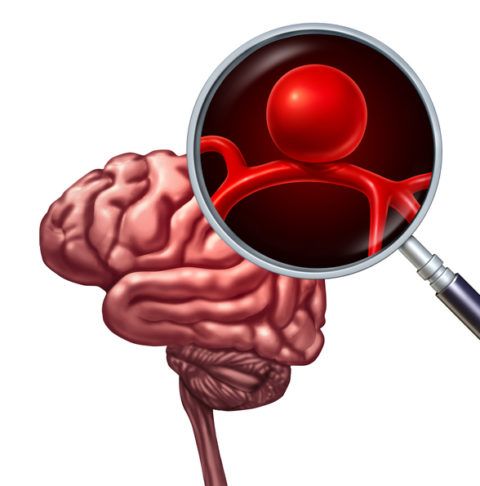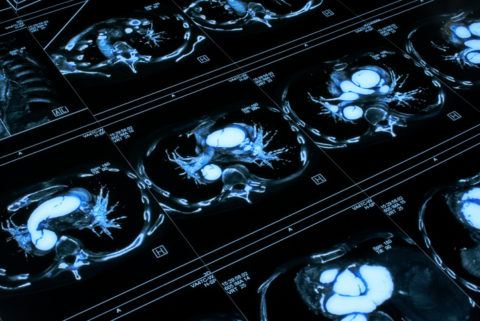What is an aneurysm and why is it produced
One of the most common cerebrovascular diseases is the aneurysm that can cause brain hemorrhage. Let's see below all the information about what is an aneurysm? with its symptoms and risk factors, as well as what types there may be.
What is an aneurysm?
A cerebral aneurysm is a pathological dilatation of the wall of a blood vessel, usually a artery , present in the brain. This inflammation of the arterial vessel is created by the flattening of the vessel wall, often favored by hypertension problems .

At the point where it is weakest, the wall stretches, thinns and expands. That is why very often the aneurysm appears as a kind of sac, in communication with the artery through a small hole, called a neck or collar, through which the blood that fills it passes. . The presence of a cerebral aneurysm is clearly a very dangerous condition . If the cerebral aneurysm is broken, in fact, the consequence is a hemorrhage that can cause irreversible damage to the brain , until the permanent vegetative state and death .
Often, cerebral aneurysms do not produce obvious symptoms , so they can be recognized occasionally during medical exams performed for other reasons. The most representative symptom in case of aneurysm rupture is a severe, sudden headache, violent and often associated with symptoms of neurological damage, such as blurred vision and double or facial paralysis. Today, fortunately, diagnostic methods and surgery allow preventive identification and intervention in most cerebral aneurysms with risk of rupture.
Causes of aneurysm
As mentioned earlier, the aneurysm is a kind of flattening of the vessel wall that can not contain the internal pressure and expands. For this reason, the possible causes of the disease, in addition to the innate, will all be able to determine a weakening of the wall of the vein or artery and, therefore:

Genetic factors
That compromise the fibers of which it is constituted the connective tissue, which is an essential component of the walls of the vessel. An example of such a situation is the Marfan syndrome which is determined by the mutation of the FBN1 gene that encodes the Fibrillin 1 protein that is a component of the connective tissue.
Atherosclerosis
The inflammatory process that accompanies the deposition of atherosclerotic plaques in the vessels can weaken the wall to such an extent that it is no longer capable of of containing the internal pressure and, therefore, it produces swelling and aneurysm.
Trauma
Any trauma ( lumps , piercings, etc. .) Localized that affects a vessel can weaken the wall and generate an aneurysm.
Infections
Mycotic and bacterial infections can cause weakening of the vessel tissues and induce aneurysm. The bacterial infections that most commonly cause aneurysm are syphilis and tuberculosis.
Vasculitis
Inflammation of the walls of the blood vessels due to various causes (infections, autoimmunity, etc.).Therefore, the copper deficiency causes problems with the walls of the vessel and, consequently, can lead to the development of aneurysms.
Cause congenital
On the other hand, in some cases the aneurysm can originate from a congenital vascular weakness (that is, present from birth).
Types of aneurysm
In general, the criteria used to diversify aneurysms are:

Morphological
That is, according to the shape and position of the protuberance of the vein or artery. According to this criterion, we can have:
- Saccular or saccular aneurysms . They have an almost spherical geometry and involve only part of the blood vessel wall. They have dimensions that vary in a range of between 5 and 20 cm in diameter. Almost always inside there is a thrombus (blood clot) that fills a good part of the lump.
- Fusiform aneurysms They have the outline of an axis. They develop symmetrically with respect to the vein or artery and at a distance that can be between 5 and 20 centimeters. They are very common in the thoracic and abdominal course of the aorta artery and, on the other hand, are very rare in the iliac artery.
- Cylindrical aneurysms . They have a cylindrical symmetry and involve very extended sections that exceed 20 cm.
- Navicular aneurysms . They are shaped like a spaceship and placed only on a small part of the wall of the vessel.
- Aneurysm dissected . that form two different paths of blood: one in the normal light of the vein and/or the artery and the other between the dry walls.
Location
That is, in which anatomical region they develop. According to this criterion, we can have:
- Aneurysms arterial. If they develop in an artery. The artery that is most frequently subject to the formation of aneurysms is the aorta in the abdominal and thoracic sections (ascending and descending).
- Venous aneurysms If they develop in a vein . The vein that is most frequently affected by aneurysms is the popliteal leg.
- Cerebral aneurysms. The vessels that supply the brain are interested. Its most recurrent location is: in the intracranial portion of the carotids, in the internal arteries and in the basilar artery.
- Renal aneurysms They can be located both in the renal artery and in the intraparenchymal vessels (vessels that spray the tissue of an organ).
- Intestinal aneurysms. If they are found in the splenic artery (irradiates the spleen) or in the mesenteric artery that arises of the aorta at the level of the first lumbar vertebra and nourishes the intestine.
- Cardiac aneurysms .Among them we mention:
- Age : the risk tends to increase after age 40;
- Gender : Women have a higher risk of developing the problem, probably due to the decrease in estrogen due to menopause, such as hormones capable of keeping the walls of the vessels elastic;
- Smoking : Studies have shown that most people diagnosed with brain aneurysm smoke or have smoked in the past; the cause is still unclear, maybe it could be related to the presence of substances that can damage the walls of the vessel;
- High blood pressure : it is a risk factor because it increases the pressure exerted by the blood on the walls;
- Hardening of the arteries (atherosclerosis),
- Family history of aneurysms, especially in first-degree relatives, such as parents or siblings, although statistically the increase in risk is reduced;
- Drug abuse, particularly cocaine, which increases the pressure blood and inflames the walls of blood vessels;
- Head injuries: This is a rare, but possible, occurrence;
- Excessive use of alcohol ,
- Specific blood infections.
Also some congenital diseases may increase the risk of an eurisma, among them we remember for example:
- Hereditary disorders of connective tissue such as Ehlers-Danlos syndrome, which weakens blood vessels.
- Polycystic kidney (polycystic kidney disease): is an inherited disorder that causes the formation of cysts in the kidneys and causes an increase in blood pressure.
- Aortic coarctation : the aorta, the artery that transports oxygen-rich blood from the heart to the rest of the body, narrows abnormally.
- Cerebral arteriovenous malformation (cerebral AVM) ): an abnormal connection between the cerebral arteries and veins disrupts normal circulation.
Interesting article:


